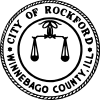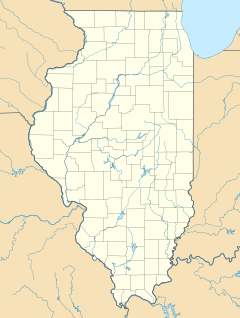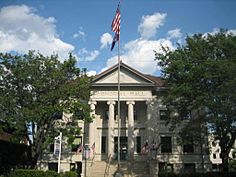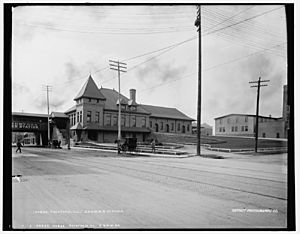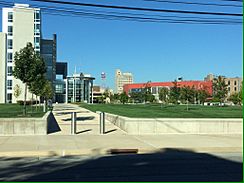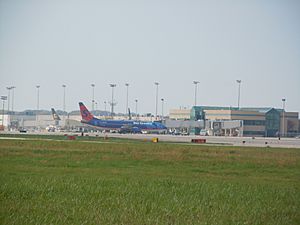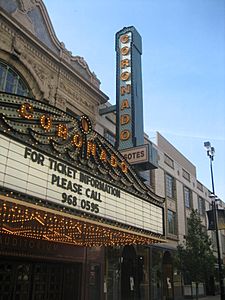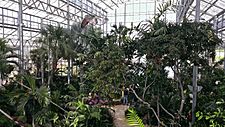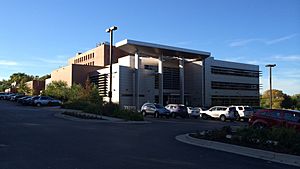Rockford, Illinois facts for kids
Quick facts for kids
Rockford, Illinois
|
|||||
|---|---|---|---|---|---|
| City of Rockford | |||||
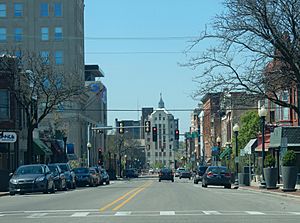
Downtown East State Street corridor
|
|||||
|
|||||
| Nicknames:
The Forest City, The Screw Capital of the World, Fastener Capital of the World, Reaper City
|
|||||
| Motto(s):
"The Government Closest to the People"
|
|||||
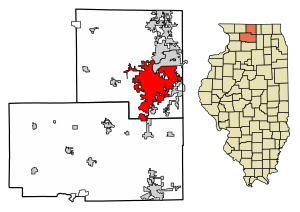
Location of Rockford in Winnebago County, Illinois
|
|||||
| Country | United States | ||||
| State | Illinois | ||||
| Counties | Winnebago and Ogle | ||||
| Township | Rockford | ||||
| Incorporated | 1839 (as a town) January 3, 1852 (as a city) |
||||
| Area | |||||
| • City | 65.92 sq mi (170.74 km2) | ||||
| • Land | 64.91 sq mi (168.11 km2) | ||||
| • Water | 1.01 sq mi (2.63 km2) | ||||
| Elevation | 728 ft (222 m) | ||||
| Population
(2020)
|
|||||
| • City | 148,655 | ||||
| • Rank | auto | ||||
| • Density | 2,290.24/sq mi (884.27/km2) | ||||
| • Metro | 344,623 | ||||
| Time zone | UTC−6 (CST) | ||||
| • Summer (DST) | UTC−5 (CDT) | ||||
| ZIP Codes |
61101–61110, 61112, 61114, 61125, 61126
|
||||
| Area codes | 815 and 779 | ||||
| FIPS code | 17-65000 | ||||
| Interstate highways | |||||
| Major airport | Chicago Rockford International Airport | ||||
| Rapid transit | Rockford Mass Transit District | ||||
| Waterways | Rock River | ||||
Rockford is a city in Winnebago County, Illinois, located in the far northern part of the state. Situated on the banks of the Rock River, Rockford is the county seat of Winnebago County (a small portion of the city is located in Ogle County). The largest city in Illinois outside of the Chicago metropolitan area, Rockford is the fourth-largest city in the state and the 171st most populous in the United States. According to 2020 U.S. Census data, the City of Rockford had a population of 148,655 with an outlying metropolitan area population of 348,360.
Settled in the mid-1830s, the position of the city on the Rock River made its location strategic for industrial development. In the second half of the 19th century, Rockford was notable for its output of heavy machinery, hardware and tools; by the twentieth century, it was the second leading center of furniture manufacturing in the nation, and 94th largest city. During the second half of the 20th century, Rockford struggled alongside many Rust Belt cities. Since the late 1990s, efforts in economic diversification have led to growth of automotive, aerospace, and healthcare industries, as well as the undertaking of various tourism and downtown revitalization efforts.
Nicknamed the Forest City, Rockford is presently known for various venues of cultural or historical significance, including Anderson Japanese Gardens, Klehm Arboretum, Rockford Art Museum, Tinker Swiss Cottage, the BMO Harris Bank Center, the Coronado Theatre, the Laurent House, and the Burpee Museum of Natural History. Its contributions to music are noted in the Mendelssohn Club, the oldest music club in the nation, and performers such as Phantom Regiment and Cheap Trick. Notable outdoor or recreational spots near Rockford are Rock Cut State Park, Atwood Homestead County Forest Preserve, and Lowden State Park.
Contents
History
Settlement and development
Rockford was founded by New Englanders in 1834 as separate settlements (commonly known as Kentville and Haightville, for the founders of each) on each side of the river and originally called Midway. At the time Rockford was founded its inhabitants consisted almost entirely of New Englanders and New England transplants from upstate New York. These were "Yankee" settlers, meaning they were descended from the English Puritans who settled New England during the early 1600s. They made up virtually all of Winnebego County's inhabitants during the first several decades of its history. In this regard the county was similar to most of the northern portion of the state of Illinois, and almost all of the neighboring state of Wisconsin. After the conclusion of the Black Hawk War there was an additional surge of immigration from New England. As a result of this heritage the inhabitants of Winnebego County considered themselves, and functioned as, a cultural expansion of early New England culture. In the Presidential election of 1860, Abraham Lincoln won 3,985 votes in Winnebago County, whereas Steven Douglas only won 817 votes.
Galena resident Germanicus Kent, his associate Thatcher Blake, and his slave Lewis Lemon are credited as the original settlers of Midway along the west bank of the Rock River; in addition, Daniel Shaw Haight is credited for completing the same task along the east bank. It was established as the county seat over rivaling communities, Winnebago and Roscoe in 1836. Due to the area's proximity to a ford across the Rock River, the village of Midway was renamed Rockford in 1837 by arriving New Englanders.
Rockford was chartered as a city in 1852, following the establishment of a post office in 1837 (of which Shaw Height served in as the first postmaster) and a weekly newspaper in 1840. Growth was fueled by the charter of Rockford Female Seminary in 1847 and a connection to the Galena and Chicago Union Railroad in 1852. The New York Tribune inspired the metonym The Forest City for Rockford in 1853.
The decision of John Henry Manny to locate production of his horse-powered combine harvester in Rockford attributed to a local rise in agricultural machinery manufacturing. Swedish furniture cooperatives did the same for their respective industry. The Rockford Union Furniture Company, under John Erlander, spearheaded these cooperatives; today, Erlander's home is a Rockford museum, demonstrating his efforts in elevating Rockford to second in furniture manufacturing in the nation, behind Grand Rapids.
In the antebellum period, Rockford shared abolitionist leanings, lending considerable support to the Free Soil Party. In 1848, 42 percent of voters in Winnebago County, which Rockford dominated as the county seat, voted for Martin Van Buren. Four years later, John P. Hale became the first presidential candidate to visit the burgeoning city, although the returns on that visit were minimal, given that he received only 28 percent of the vote. During the Civil War, one of the first Illinois regiments to be mobilized, the Zouaves, were from Rockford, which served as the site for Camp Fuller, a training site for four other infantry regiments.
The Rockford Female Seminary became the alma mater of Jane Addams in 1881. This move accompanied the Seminary's transition into a more complete curriculum, which was represented by its renaming to Rockford College in 1892. Culture flourished with the founding of the Mendelssohn Club in 1884, which became the oldest operating music club in the United States. This was complemented by the construction of a Carnegie library in 1902, which became the first building of Rockford's public library system. 1903 saw the dedication of the Winnebago County Veterans Memorial Hall in the presence of sitting President Theodore Roosevelt. Roosevelt returned to Rockford during his campaign in 1912 and later to address the soldiers at Camp Grant, a training site for World War I soldiers.
Twentieth century
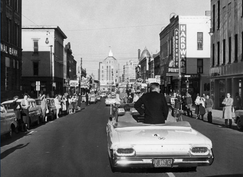
The twentieth century saw demographic changes to Rockford. An influx of Italians, Poles, Lithuanians, and African Americans replaced the previously dominant Irish and Swedes. The city was also no stranger to contemporary political issues. Electorally divided between wets and drys on the subject of prohibition, Rockford featured a coalition of labor unionists and socialists that elected numerous aldermen and carried 25 to 40 percent in mayoral elections. During World War I, an antiwar protest by the International Workers of the World led to 118 arrests. In 1920, the city was a target of the Palmer Raids. While its congressional district favored Republicans, Rockford itself continuously elected former Socialists as mayor between 1921 and 1955.
Prior to World War II, Rockford became home to Kegel Harley-Davidson, which became the oldest family-owned Harley-Davidson dealership in existence. One of its contemporary attractions, the Coronado Theatre, was opened in 1927. Notable for its atmospheric styling, the Coronado rivaled its counterparts in Chicago and was later added to the National Register of Historic Places in 1979. Camp Grant was turned over to the Illinois National Guard. During the war, it reopened as an induction center and POW detention camp. The USS Rockford, a Tacoma-class frigate named for the city, was commissioned in March 1944 and earned two service stars.
In the September 1949 issue of Life magazine, postwar Rockford was described as "nearly typical of the U.S. as any city can be." Due to this archetypal nature, sociologists like W. Lloyd Warner warned of the necessity to "understand the realities of their system." Heavily dependent on manufacturing and experiencing a shift in economic development toward its eastern borders, Rockford began to suffer irrevocable decline. Impetuses for this shift in economic development include the construction of the Northwest Tollway in 1958, the new campus for Rockford College in 1964, and the campus of Rock Valley College and the Chrysler Belvidere Assembly Plant in 1965 near the eastern periphery of the city rather than downtown.
Efforts to revitalize the downtown were made in the 1970s with the construction of a pedestrian mall and a ten thousand-seat multipurpose arena. The former sectioned off Rockford's Main Street, impeding vehicle traffic, to the criticism of nearby business owners. The latter, the MetroCentre, opened in 1981 to performances by Dionne Warwick and The Rolling Stones. State grants were also consulted to reverse the trend, such as those that funded an Alexander Liberman sculpture placed at a downtown intersection in 1978. However, further decay occurred in the 1980s, such as the end of Amtrak service on the Black Hawk rail route from Chicago in 1981 and the closure of the Coronado Theatre due to declining revenues in 1984.
Twenty-first century
Economic diversification has been difficult but ongoing for the area. The aerospace industry, represented by Woodward and UTC Aerospace Systems, is dominant in Rockford. Loves Park, a suburb, was selected by Woodward for a $200 million manufacturing campus toward its energy control and optimization systems in 2012. Boeing included Rockford in a list of five finalists to manufacture the 777X during union disputes in 2014. The healthcare industry, represented by OSF Saint Anthony Medical Center and SwedishAmerican Hospital, is also involved. SwedishAmerican, in partnership with the University of Wisconsin Carbone Cancer Center, opened a $39 million Regional Cancer Center in 2013.
Downtown improvements became more evident in the first decade. The Coronado Theatre reopened after an $18.5 million renovation in 2001. The controversial pedestrian mall was removed, returning Main Street to a two-lane thoroughfare complete with cafe-style seating and wind-powered streetlights. The MetroCentre underwent a $20 million renovation, prompting interest in the purchasing of its naming rights; the arena was subsequently renamed the BMO Harris Bank Center. An open-air amphitheatre and a riverwalk were constructed to tie the Discovery Center Museum and the Burpee Museum of National History together. Most significantly, the Stanley J. Roszkowski U.S. Courthouse was constructed for $100 million and the restoration of daily Black Hawk rail service began, scheduled for completion in 2015, for $223 million.
Even before the Great Recession had an effect on Rockford, the city was impacted by flooding of its Keith Creek in both 2006 and 2007. Grants were won from FEMA to widen the creek and demolish over one hundred homes to stem the severity of future floods. Since the crisis set in, population has only declined. Thirty two percent of the area's mortgages were underwater by 2013; Forbes rated Rockford number three on its America's Most Miserable Cities list in the same year. In the first four months of 2014, the unemployment rate of Rockford declined from 12.9 percent to 9.2 percent, but these figures remained well above the national average.
The emphasis given to eastern areas in Rockford have rendered their western counterparts with blighted neighborhoods. In 2002, Rockford's public school system was court-ordered to spend $250 million on upgrades to western schools after it was found culpable for discrimination against residents served by them, many of whom were African American.
Geography
According to the 2010 census, Rockford has a total area of 61.949 square miles (160.45 km2), of which 61.08 square miles (158.20 km2) (or 98.6%) is land and 0.869 square miles (2.25 km2) (or 1.4%) is water. Neighboring communities that border Rockford, and are considered an integral part of the Rockford metro area, are the cities of Loves Park, Machesney Park, Belvidere, and the villages of Winnebago, Roscoe, Rockton, Poplar Grove, New Milford, and Cherry Valley. The Rock River is the traditional center of the Rockford area and is its most recognizable natural feature. Also of note, South Beloit, Illinois and Beloit, Wisconsin are part of this continuous urban area that stretches for approximately 30 miles along the Rock River from the Chicago Rockford International Airport north to the Southern Wisconsin Regional Airport.
Climate
Due to its location in the Midwest, naturally a deciduous forest, Rockford's climate contains four clearly defined seasons. Summers are usually hot with the average high temperature in July, the hottest month, being 84.5 °F (29.2 °C). The winter months can bring bitterly cold air masses from Canada. The average high temperature in January, the coldest month, is 29.5 °F (−1.4 °C). June is Rockford's wettest month while January is the driest. During a typical year, Rockford receives 36.2 inches (919.6 mm) of precipitation.
Rockford and surrounding areas are prone to violent thunderstorms during the months of March, April, May, and June. On April 21, 1967, the neighboring town of Belvidere was struck by a violent F4 tornado, in which twenty-four people were killed and hundreds more injured at Belvidere's High School. Other severe weather events, such as hail and strong winds are common in these storms. On July 5, 2003 at 04:13, supercells produced tornadoes causing widespread damage on both the east and west sides of Rockford. Approximately 70,000 people were without power, with many on the west side suffering in the heat without electricity for a week. It took months for the damage to be completely cleared, but because the storm struck so early in the morning there were no injuries or fatalities. However, these sometimes violent storms bring the majority of summer rainfall.
The city is also prone to severe snowstorms in winter, and blizzards are frequent winter occurrences. On January 13, 1979 over 9 inches (23 cm) of snow fell on Rockford in just a few hours during one of the strongest blizzards in the city's history. The city averages approximately 36 inches (91.4 cm) of snowfall in a normal winter, but greater amounts are common. The snowiest winter in the history of the city was the winter of 1978–1979, when 75 inches (191 cm) of snow fell.
The record high temperature is 112 °F (44 °C), set on July 14, 1936 during the Dust Bowl, and the record low temperature is −27 °F (−33 °C), set on January 10, 1982, though a low of −25 °F (−32 °C) has occurred as recently as January 16, 2009.
| Climate data for Rockford, Illinois (Chicago Rockford International Airport), 1981−2010 normals & extremes | |||||||||||||
|---|---|---|---|---|---|---|---|---|---|---|---|---|---|
| Month | Jan | Feb | Mar | Apr | May | Jun | Jul | Aug | Sep | Oct | Nov | Dec | Year |
| Record high °F (°C) | 63 (17) |
70 (21) |
85 (29) |
93 (34) |
106 (41) |
106 (41) |
112 (44) |
104 (40) |
103 (39) |
91 (33) |
81 (27) |
69 (21) |
112 (44) |
| Mean maximum °F (°C) | 48.9 (9.4) |
53.1 (11.7) |
71.3 (21.8) |
81.6 (27.6) |
86.8 (30.4) |
92.6 (33.7) |
93.6 (34.2) |
92.7 (33.7) |
89.1 (31.7) |
81.1 (27.3) |
66.8 (19.3) |
51.8 (11.0) |
95.7 (35.4) |
| Average high °F (°C) | 29.5 (−1.4) |
34.2 (1.2) |
46.9 (8.3) |
60.7 (15.9) |
71.8 (22.1) |
81.1 (27.3) |
84.5 (29.2) |
82.4 (28.0) |
75.4 (24.1) |
62.7 (17.1) |
47.6 (8.7) |
33.2 (0.7) |
59.3 (15.2) |
| Average low °F (°C) | 13.5 (−10.3) |
17.7 (−7.9) |
27.5 (−2.5) |
38.1 (3.4) |
48.4 (9.1) |
58.5 (14.7) |
63.0 (17.2) |
61.3 (16.3) |
52.4 (11.3) |
40.7 (4.8) |
30.3 (−0.9) |
17.7 (−7.9) |
39.2 (4.0) |
| Mean minimum °F (°C) | −10.6 (−23.7) |
−4.4 (−20.2) |
8.8 (−12.9) |
21.6 (−5.8) |
33.6 (0.9) |
44.8 (7.1) |
51.5 (10.8) |
49.9 (9.9) |
36.0 (2.2) |
25.4 (−3.7) |
13.7 (−10.2) |
−4.5 (−20.3) |
−15.3 (−26.3) |
| Record low °F (°C) | −27 (−33) |
−25 (−32) |
−11 (−24) |
5 (−15) |
24 (−4) |
35 (2) |
43 (6) |
35 (2) |
24 (−4) |
7 (−14) |
−10 (−23) |
−24 (−31) |
−27 (−33) |
| Average precipitation inches (mm) | 1.37 (35) |
1.41 (36) |
2.32 (59) |
3.35 (85) |
4.02 (102) |
4.65 (118) |
3.95 (100) |
4.59 (117) |
3.35 (85) |
2.67 (68) |
2.58 (66) |
1.98 (50) |
36.24 (921) |
| Average snowfall inches (cm) | 10.2 (26) |
7.7 (20) |
4.8 (12) |
0.9 (2.3) |
trace | 0 (0) |
0 (0) |
0 (0) |
0 (0) |
0.1 (0.25) |
1.7 (4.3) |
11.3 (29) |
36.7 (93) |
| Average precipitation days (≥ 0.01 in) | 9.4 | 8.2 | 10.5 | 11.3 | 12.2 | 10.4 | 9.4 | 9.7 | 8.3 | 9.4 | 10.2 | 10.2 | 119.2 |
| Average snowy days (≥ 0.1 in) | 8.2 | 5.8 | 4.1 | 1.0 | 0 | 0 | 0 | 0 | 0 | 0.1 | 1.8 | 7.7 | 28.7 |
| Source: NOAA (extremes 1893–present) | |||||||||||||
Demographics
| Historical population | |||
|---|---|---|---|
| Census | Pop. | %± | |
| 1860 | 6,979 | — | |
| 1870 | 11,049 | 58.3% | |
| 1880 | 13,120 | 18.7% | |
| 1890 | 23,584 | 79.8% | |
| 1900 | 31,051 | 31.7% | |
| 1910 | 45,401 | 46.2% | |
| 1920 | 64,651 | 42.4% | |
| 1930 | 85,864 | 32.8% | |
| 1940 | 84,637 | −1.4% | |
| 1950 | 92,927 | 9.8% | |
| 1960 | 126,706 | 36.4% | |
| 1970 | 147,370 | 16.3% | |
| 1980 | 139,712 | −5.2% | |
| 1990 | 139,426 | −0.2% | |
| 2000 | 150,115 | 7.7% | |
| 2010 | 152,871 | 1.8% | |
| 2020 | 148,655 | −2.8% | |
| U.S. Decennial Census 2010 2020 |
|||
2020 census
| Race / Ethnicity | Pop 2010 | Pop 2020 | % 2010 | % 2020 |
|---|---|---|---|---|
| White alone (NH) | 89,349 | 72,440 | 58.45% | 48.73% |
| Black or African American alone (NH) | 30,695 | 33,466 | 20.08% | 22.51% |
| Native American or Alaska Native alone (NH) | 308 | 308 | 0.20% | 0.21% |
| Asian alone (NH) | 4,390 | 5,145 | 2.87% | 3.46% |
| Pacific Islander alone (NH) | 36 | 30 | 0.02% | 0.02% |
| Some Other Race alone (NH) | 218 | 715 | 0.14% | 0.48% |
| Mixed Race/Multi-Racial (NH) | 3,790 | 6,968 | 2.48% | 4.69% |
| Hispanic or Latino (any race) | 24,085 | 29,583 | 15.76% | 19.90% |
| Total | 152,871 | 148,655 | 100.00% | 100.00% |
Note: the US Census treats Hispanic/Latino as an ethnic category. This table excludes Latinos from the racial categories and assigns them to a separate category. Hispanics/Latinos can be of any race.
2010 Census
As of the 2010 census, there were 152,871 people and 66,700 households. Rockford is in the center of its namesake metropolitan area. The racial makeup of the city was 65.1% White (58.4% Non-Hispanic white), 20.5% African American, 0.4% Native American, 2.9% Asian, 0.01% Pacific Islander, 7.5% from other races, and 3.6% from two or more races. Hispanic or Latino of any race were 15.8% of the population.
The median income for a household in the city was $55,667, and the median income for a family was $65,465. Males had a median income of $37,098 versus $25,421 for females. The per capita income for the city was $19,781. 14.0% of the population and 10.5% of families were below the poverty line. 19.6% of those under the age of 18 and 8.0% of those 65 and older were living below the poverty line.
In the late 1950s, Rockford surpassed Peoria as the second largest city in Illinois by population, holding onto that position into the 21st century. In 2003, the status was changed as it was overtaken by Aurora after the results of a special census held by the latter city (as the two cities were not counted together, a direct comparison was not possible until the national census in 2010).
Religion
Like many other Rust Belt and midwestern cities, Catholics make up Rockford's largest religious group. According to 2010 figures, 20% of Winnebago County residents are Catholic, 19% are Evangelical, 10% are Mainline Protestant and 48% belong to a non-listed faith or have no religion. The Roman Catholic Diocese of Rockford, several large evangelical and non-denominational churches, and several Lutheran and other Mainline Protestant congregations serve Rockford's Christian community. Rockford's Jewish community is served by a synagogue, the Muslim community by a mosque, the Sikhs by a temple, and its Buddhist community is served by two houses of worship.
Transportation
Roads and highways
By highway, Rockford is linked by highway to Wisconsin (Madison, Milwaukee), Iowa (Dubuque), and many parts of Illinois. In the past 30 years, the centralized location of the region has worked to an advantage in attracting jobs in the logistics and transportation industries.
Public transportation in the city is provided by the Rockford Mass Transit District (RMTD).
- Interstate 90

- Known as the Northwest Tollway before 2007, the Jane Addams Memorial Tollway links the city to Madison, Wisconsin and the northwest Chicago suburbs. From Rockford north, I-90 replaces U.S. Route 51 in Illinois. I-90 also links the city with Milwaukee, Wisconsin, as I-43 joins it 2 miles north of the state line.
- Originally placed several miles east of the city, the Northwest Tollway would play a role in the rapid growth of the eastern half of Rockford in the later 20th century.
- U.S. Route 20

- U.S. Route 20 travels through Rockford two different ways. The original route is now marked as a four-lane east/west business route (State Street) that divides the city to the north and south; the eastern 3 miles of State Street were expanded to six lanes in the late 1980s and 1990s to accommodate heavier commercial traffic. From the late 1970s to the end of the 20th century, this area played a key role in commercial development in Rockford.
- In 1965, a four-lane US 20 bypass was completed. Not a true beltway (as it does not encircle the city), the bypass starts from Interstate 90 near Cherry Valley, concurrent with Interstate 39/US 51; forming the northern terminus of I-39, the bypass links it with I-90 (carrying it into Wisconsin). Continuing westward, the bypass travels over Illinois 251 (the original routing of US 51) and Illinois 2 before traveling northwest, allowing it merge together with the business route (West State Street) approximately two miles west of the city limits.
- West of Rockford, US 20 (also known as the Grant Memorial Highway) provides a link to Freeport, Galena, and Dubuque, Iowa; much of the highway west of Freeport is a winding two-lane road that discourages truck traffic. To the east, US 20 roughly parallels I-90, eventually becoming a major central thoroughfare in several Chicago suburbs. The start of the US 20 bypass in Cherry Valley marks the end of where the two highways parallel each other in the United States.
- Interstate 39
 and U.S. Route 51
and U.S. Route 51 
- U.S. Route 51 travels through Rockford twice; the original alignment of the highway is now renamed Illinois Route 251. Entering through southeast Rockford through New Milford, Route 251 travels through the eastern half of the city among several major surface streets. As it exits Rockford, Route 251 serves as the primary north-south thoroughfare of its northern suburbs, from Loves Park to South Beloit.
- During the late 1970s and early 1980s, US 51 was replaced by the construction of Interstate 39. Directly connecting Rockford to Bloomington-Normal, I-39 has a northern terminus at the US 20 bypass and is connected to I-90, using the latter route to access I-90. The north-south four-lane interstate gives access to Peoria and the Quad Cities; with access to Interstate 80 and Interstate 88, Interstate 39 allows for Rockford access to the southern suburbs of Chicago, also serving as a bypass around Chicago to Wisconsin.
- Other roads/highways
-
 Illinois Route 2 (South/North Main Street)
Illinois Route 2 (South/North Main Street) Illinois Route 70 (Kilburn Avenue)
Illinois Route 70 (Kilburn Avenue) Illinois Route 251 (North Second Street, Kishwaukee Street, Harrison Avenue, 11th Street)
Illinois Route 251 (North Second Street, Kishwaukee Street, Harrison Avenue, 11th Street)- Raoul Wallenberg Expressway (proposed, never built)
Bus
The Rockford Mass Transit District (RMTD) provides fixed-route and paratransit service, with a service area including Rockford, Loves Park, and Machesney Park. The 40 fixed route buses operate over 17 routes Monday thru Saturday, 6 night routes and 5 routes on Sundays.
Current intercity bus providers in Rockford are Greyhound Lines and Van Galder Bus Company.
Bicycle-sharing system
In April 2018, Rockford became included in the LimeBike bicycle-sharing network. Using 500 commuter bicycles supplied by the company, residents rent bicycles through a mobile app, unlocking the dockless bicycles. Distinguished by their bright green color, LimeBikes are equipped with a basket, lights, and GPS (to locate them for rental); one-speed and three-speed units are in use.
In early 2019, LimeBike was discontinued in Rockford; the company shifted its business model away from bicycles to e-scooters.
Air
The first airport serving the Rockford area was Machesney Airport, located north of the city alongside US 51. Opened in 1927, the airport was initially a private airport; during World War II, it was utilized by the Army Air Corps. After the war, Machesney Airport was opened as a municipal airport. In 1974, the location was closed, becoming the site of the Machesney Park Mall in 1980.
Following the final closure of Camp Grant in 1946, the state legislature allowed for the establishment of an airport to serve Rockford, leading to the creation of the Greater Rockford Airport Authority (GRAA). In 1948, the GRAA received a 1500-acre portion of the Camp Grant property between US 51 and the Rock River, located between the southern border of the city and New Milford.
From the 1950s to 1970s, the Greater Rockford Airport served as a regional airport, with small airlines offering both turboprop and jet service. To further expand passenger service, the current passenger terminal was constructed in 1987. Competing against easy highway access (and bus service) to O'Hare International Airport, the airport struggled for passenger service during the 1990s, leading to the loss of passenger service from 2001 to 2003. Since 2003, the airport has restored passenger service, primarily marketing its location for leisure travelers. Following the closure of several airlines, the location is served by Allegiant Air as its passenger carrier. Following a 2005 upgrade, the passenger terminal was expanded in size in 2018.
During the 2000s, the airport underwent several name changes, adopting the current Chicago Rockford International Airport moniker in 2007. Among the fastest-growing freight airports in the world, full-scale cargo operations began in 1994 as United Parcel Service (UPS) opened an air package hub at the airport next to the terminal. Second only to Worldport in the UPS Airlines operations, the Rockford UPS hub operates on a separate 50-acre ramp (parking up to 40 aircraft at a time), accommodating up to a Boeing 747-8F.
Next to the UPS facilities, another cargo ramp was built in 2008, intended to attract additional cargo airlines. In 2016, the facilities were leased by ABX, intending to transfer freight from aircraft to trucks; the operations transitioned into flights for Amazon Air, who partners with ABX, ATI, and Atlas Air. The same year, AAR Corporation opened an FBO facility on the southern end of the airport, building hangars large enough to accommodate an Airbus A380. In 2021, cargo operations were expanded further, as the airport constructed an additional cargo-handling facility and cargo ramp, introducing service by German air cargo company Senator International, contracting 747s by Air Atlanta Icelandic. In 2022, Korean Air Cargo introduced cargo service from Seoul to Rockford on 777-300 freighters, becoming the longest flight from the airport.
Rail
Passenger
For over four decades, the Rockford region has not been served by passenger rail. From 1974 to 1981, Rockford was served by Amtrak via its Black Hawk route, a daily train service from Dubuque, Iowa to Union Station in Chicago with a stop in Rockford. The Black Hawk was discontinued in September 1981 as part of funding cuts to Amtrak.
During the 2000s, interest increased in relinking the Rockford and Chicago regions by rail. In 2006, the Northern Illinois Commuter Transportation Initiative proposed extending Metra train service from the western Chicago suburbs to Rockford. While Metra service has yet to be proposed on an official level, during the early 2010s, there was design work on a planned 2015 revival of the Black Hawk route on Canadian National rails, with Rockford as the initial terminus. As part of the ongoing Illinois financial crisis, state funding for the Black Hawk revival was suspended in February 2015, putting the project on hold.
Freight
Rockford is served by several different freight railroad lines, the Union Pacific, the Canadian National, the Iowa, Chicago & Eastern (Canadian Pacific), and the Illinois Railway. The Union Pacific line from West Chicago terminates in Rockford at a small yard.
The Canadian National line from Elgin enters from the Southeast and leaves in the Northwest. They have a small yard where they interchange with the Illinois Railway. The Illinois Railway Rockford Line comes from the South, joins the Canadian National line, where they continue on trackage rights to the Canadian National yard. Canadian Pacific (Iowa, Chicago, and Eastern) runs on Illinois Railway trackage rights from Davis Junction, and leaves on their own trackage to the North. All of the railroads interchange at a yard off of Main Street.
The Union Pacific Railroad's Global III Intermodal Facility is approximately 25 miles (40 km) south of Rockford in Rochelle, Illinois, a community of 10,000. The complex is one of the world's largest intermodal facilities. Construction on the state-of-the-art facility was completed in 2003 in Rochelle due to the close proximity to four interstate highways (I-39, I-88, I-80, and I-90) and rail routes.
Culture and tourism
The attractions of Rockford are often of architectural significance. The Lake-Peterson House, constructed by alderman John Lake in 1873 and preserved by Swedish industrialist Pehr August Peterson, is a notable example of Gothic Revival. Added to the National Register of Historic Places in 1980, it is contemporarily used for the School of Medical Technology of the Rockford-based Swedish American Hospital. Further Swedish influence on Rockford during the Victorian era is represented in the Erlander Home Museum, the base of the Swedish Historical Society. Swiss influence can be seen in the Tinker Swiss Cottage, which was opened as a museum under the park district in 1943 and was featured in an episode of Ghost Hunters in 2012.
Modern architectural movements, like Art Deco and Prairie School, are also integral to Rockford. Most renowned is the Coronado Theatre, a civic and entertainment center that was named one of 150 Great Places in Illinois by the American Institute of Architects. The theatre is known for its blend of Art Deco with Spanish Baroque Revival and has hosted numerous performers over its lifetime, including the Marx Brothers, Frank Sinatra, and Bob Dylan. The 186-foot tall Faust Hotel complements the Coronado; constructed in 1929, it endures as Rockford's tallest building, albeit as apartments for the elderly and disabled. The Laurent House, a single-story Usonian home constructed in 1952 by Frank Lloyd Wright, is the only Wright building designed for a person with disabilities. Acquired by a private foundation from its commissioners, it was renovated into a museum in 2014.
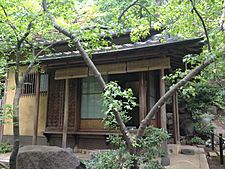
The area is often regarded as an outdoor destination. Rock Cut State Park is located to the northeast of the city. Once home to various Scots, Canadians, and New Englanders, as well as a railroad line to Kenosha, the park's 3,092 acres are now utilized for camping, hiking, fishing and boating, and hunting. Anderson Japanese Gardens, modeled after the Portland Japanese Garden and landscaped by Hoichi Kurisu, is 10 acres in size and features a teahouse and guesthouse in the sukiya-zukuri style. John Anderson, the commissioner of the gardens, was presented with a commemorative silver cup by Japan for his efforts in the mutual understanding of cultures in 1992; he donated the gardens to a nonprofit organization later in 1998. Klehm Arboretum and Botanic Garden is 155 acres in size and is noted for its selection of both indigenous and foreign plant species.
The city's park district is particularly active. It operates Aldeen Golf Course, which was rated the best municipal golf course in Illinois by Golf Digest and one of the top fifty golf courses in the nation that cost under $50 to play by Golf Magazine. In addition to Tinker Swiss Cottage, the park district maintains four other museums. The Burpee Museum of Natural History is home to the world's most complete juvenile Tyrannosaurus rex, Jane, as well as a triceratops, Homer. The Discovery Center Museum, a children's museum featuring over 250 hands-on exhibits including a planetarium, is on the 12 Best Children's Museums In The U.S. list by Forbes. The Burpee Museum and the Discovery Center Museum, along with the Rockford Art Museum and the bases for Northern Public Radio, the Rockford Dance Company, and the Rockford Symphony Orchestra compose the downtown Riverfront Museum Park complex. The last museum under the park district's authority is Midway Village and Museum Center, a recreation of a Victorian era village. However, it also maintains the third largest conservatory in Illinois, the Nicholas Conservatory and Gardens, on the city's eastern riverwalk. The conservatory is adjacent to the Symbol, a Alexander Liberman sculpture that was moved from downtown during the 1980s and is now one of Rockford's most recognizable features.
Surrounding communities and suburbs
Sister cities
 Brovary, Ukraine since 1995
Brovary, Ukraine since 1995 Changzhou, Jiangsu, China since 1999
Changzhou, Jiangsu, China since 1999 Borgholm, Sweden since 2002
Borgholm, Sweden since 2002 Cluj-Napoca, Romania since 2005
Cluj-Napoca, Romania since 2005 Ferentino, Italy since 2006
Ferentino, Italy since 2006 Tokmok, Kyrgyzstan
Tokmok, Kyrgyzstan Taszár, Hungary
Taszár, Hungary
Economy
Largest employers
As of January 2017, the ten largest employers in Rockford, Illinois are:
| Rank | Company/organization name | # of employees |
|---|---|---|
| 1 | Fiat Chrysler Automobiles (Belvidere Assembly Plant) | 4,323 |
| 2 | Rockford Public School District 205 | 3,525 |
| 3 | Mercy Health | 3,195 |
| 4 | SwedishAmerican Health System | 2,988 |
| 5 | OSF Healthcare | 2,800 |
| 6 | Collins Aerospace | 2,200 |
| 7 | Walmart Stores | 1,611 |
| 8 | Woodward, Inc. | 1,540 |
| 9 | PCI - Packaging Coordinators, Inc. | 1,500 |
| 10 | Winnebago County | 1,449 |
Other industry
Mrs. Fisher's, also known as Mrs. Fishers Potato Chips, a regional manufacturer of potato chips founded in Rockford, is a recognized brand name of potato chips in parts of the Midwestern United States. Since 1923, Rockford has been home to Kegel Harley-Davidson; owned by the same family since 1912, it is the oldest family-owned Harley-Davidson franchise in existence.
Sports teams
Current
- Rockford IceHogs (ice hockey; UHL 1999–2007, AHL 2007–present)
- Rockford Rivets (baseball; NWL 2015–present)
- Rockford Rage (women's roller derby; 2006–present)
- Rockford Raptors (indoor football)
Historical
- Rockford Forest Citys (baseball, 1871)
- Rockford Peaches (women's baseball; AAGPBL, 1943–1954)
- Rockford Lightning (basketball; CBA, 1986–2005)
- Rockford Aviators (baseball; Frontier League 2002–2009, Northern League 2010, Frontier League 2011–2015)
- Rockford Rampage (indoor soccer; AISL 2005–2008, NISL 2008-2010)
- Rockford Fury (basketball; PBL, 2006–2008)
- Rockford Foresters (baseball; Midwest Collegiate League 2010–2013)
Rockford Peaches
From 1943 to 1954, the Rockford Peaches were an inaugural team of the All-American Girls Professional Baseball League. Playing home games at Beyer Stadium, the Peaches won league championships in 1945, 1948, 1949, and 1950; the four championships are the most of any league member.
The Rockford Peaches and the league itself were portrayed in the 1992 motion picture A League of Their Own. However, the characters in the film are fictional; the Peaches did not compete for the 1943 league championship (as depicted in the film). Production of the film did not feature the city of Rockford; as it had largely become abandoned and fallen into disrepair, Beyer Stadium was demolished at the beginning of the 1990s.
Education
Post-secondary
Although Rockford is in a large metropolitan area, the region does not have any public 4-year universities; the closest such institution is Northern Illinois University in DeKalb, 45 miles (72 km) away. Along with Rockford University (a private 4-year school of just under 2000 students), the city is the home to Rock Valley College (a 10,000-student community college), Rockford Business College (re-branded as Rockford Career College in 2009), and St. Anthony College of Nursing.
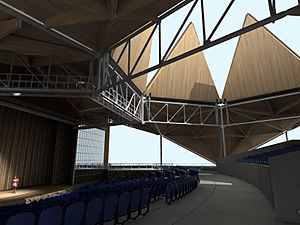
In addition, it hosts several satellite branches of other schools, including Judson University (based in Elgin), Northern Illinois University (based in DeKalb), Rasmussen College, Embry–Riddle Aeronautical University as a part of their "worldwide campus", and the University of Illinois College of Medicine (based in Chicago).
Rockford University is best known for graduating Jane Addams, recipient of the Nobel Peace Prize in 1931 for her efforts to promote international peace and justice. Laura Jane Addams (1860–1935) entered what was then Rockford Female Seminary in 1877 and became the first graduate to receive a B.A. degree from the newly accredited baccalaureate institution in 1882 (the school was renamed Rockford College in 1892, and Rockford University in 2013).
Rock Valley College is a community college with several locations in the Rockford area. The main campus is the site of the Bengt Sjostrom Theatre. The former outdoor theatre now features a motorized retractable roof constructed during 2003.
Public School District 205
Serving Rockford, Cherry Valley, and portions of Winnebago and Boone counties, Rockford Public School District 205 covers an area of roughly 170 square miles (440 km2). With approximately 27,000 students, it is the state's fourth-largest school district by enrollment. District 205 has four high schools (Auburn, East, Guilford, and Jefferson), six middle schools, and 29 elementary schools. It also operates early-childhood and alternative education centers. Beginning with the class of 2021, graduates of the Rockford Public Schools and residents within the city of Rockford with a cumulative 3.0 GPA can attend Northern Illinois University tuition free. This location-based scholarship program is a partnership between Rockford Public Schools, Northern Illinois University, Rockford Promise and the city of Rockford.
Private schools
In addition to its public school system, Rockford supports 27 sectarian and nonsectarian private schools ranging from elementary to secondary education.
Notable people
Images for kids
See also
 In Spanish: Rockford (Illinois) para niños
In Spanish: Rockford (Illinois) para niños



